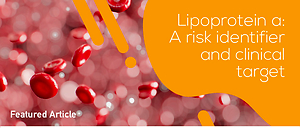Lipoprotein a, Lp(a), is a plasma lipoprotein composed of a low-density lipoprotein (LDL) particle that is covalently linked to apolipoprotein(a) (Apo-Β100) by a disulfide bond. On an equimolar basis, Lp(a) is more atherogenic than LDL, because the additional apolipoprotein(a) component may exacerbate atherothrombosis by promoting vascular inflammation, and its potential antifibrinolytic activity is associated with inhibition of plasminogen. Lp(a) levels are 75–95% inheritable and predominately determined by single-nucleotide variants at the LPA gene and copy number variants specifically in the Kringle IV type 2 domain1-3. The Apo(a) gene contains genetic sequences called Kringles, structurally relevant to those of plasminogen gene. Sequences of Kringle IV/Kringle V of Apo(a) present close resemblance to plasminogen, reaching 80–90%, and the active enzymic region differs only to arginine substitution by serine in the case of Apo(a). This small differentiation is important because it makes the Apo(a) particle not able to be activated and switched to enzymic action mode. Due to this similarity, Lp(a) distorts the thrombolytic process and induces thrombosis. In some of Kringle IV Apo(a) genetic sequences, lysine binding sites (LBS) are found which are located in Apo-B100, in fibrinogen, and in fibrin. These connecting sites have a major role in the fibrinolytic suppression action of Apo(a). Lp(a) induces plasminogen activator inhibitor (PAI-1) production which is located in endothelial and lean muscle cells of normal vessels and in large amounts in atheromatic plaques. PAI-1 regulates the fibrinolytic system, thus Lp(a) acts as a thrombotic factor4-6. Lp(a) is thought to augment cardiovascular disease (CVD) risk through both pro-atheromatic pathways due to the lipid LDL core and prothrombotic and proinflammatory pathways due to Apo(a)7. Lp(a) small isoforms are linked to high Lp(a) serum levels and augmented coronary artery disease risk8,9.
Therefore, screening for Lp(a) genetic factors would be expected to have an added value and be proven cost-effective in primary prevention, whereas monitoring Lp(a) serum levels could enhance the clinical risk prediction of atherosclerotic incidents in CV patients.
Pathophysiology, epidemiology and genetics data support the causal role of Lp(a) in cardiovascular disease and at the same time in aortic valve calcification and stenosis. Lp(a) increased levels are the most prominent single gene lipid disorder worldwide, since 1.4 billion people present Lp(a) values >30 mg/dL. Lp(a) associated risk becomes crucial in light of the emerging treatments currently underway for an effective reduction of its levels.
Current guidelines ask for at least one measurement of Lp(a) levels in adults, and at Lp(a) levels >180 mg/dL, the lifetime cardiovascular risk equals that of heterozygous familial hypercholesterolemia. It has been found that a significant reduction of Lp(a) levels is needed to drastically reduce CVD risk and that 100 mg/dL Lp(a) level reduction is comparable to 40 mg/dL LDL reduction10. Older hypolipidemic drugs, with the exception of niacin, were not able to achieve such reduction levels. Lomitapide and mipomersen achieved Lp(a) levels reduction of 17% and 25%, respectively; PCSK9 inhibitors therapy led to 30% reduction, and an almost 70% reduction was achieved by Lp(a) lipoprotein apheresis sessions11,12.
Newer antisense nucleotides therapy such as pelacarsen depending on the drug doses used, has led to dramatic Lp(a) levels reductions, namely 72% at the dose of 60 mg per month and 80% at the dose of 20 mg per week, making it possible to achieve the target of Lp(a) <50 mg/dL13-15.
In the SPS2-THRIVE study, cardiovascular risk reduction was found when Lp(a) levels were reduced by 50–60 mg/dL, while in the ODYSSEY clinical trial, Lp(a) reduction by 41 mg/dL produced a 22% reduction of CVD events. It is important to note that when Lp(a) levels are significantly high, the drastic reduction of LDL levels is mandatory for CVD risk reduction, while an additive positive effect is achieved with the parallel reduction of both high LDL and Lp(a) levels16.
Keeping in mind the relevant data on the role of Lp(a) both as a risk marker and as a target in both primary and secondary prevention, and the central role of Αpo-B100 containing lipoproteins in initiation and progression of atherosclerosis, Lp(a) serum levels measurement in all adults becomes highly recommended, especially for coronary artery disease patients and their first-degree blood relatives.
It is evident that high Lp(a) levels actually signify high cholesterol levels. As a rule-of-thumb, if Lp(a) levels are divided by 3, the contained cholesterol levels are estimated. In the case of Lp(a) in the range of 210 mg/dL, the contained cholesterol is roughly 70 mg/dL, thus the risk linked to cholesterol deposition in the coronary vessels and aortic valve increases. Lp(a) levels above the >90th percentile, i.e. 77 mg/dL, double the risk for a CVD event, while levels >100 mg/dL double the risk of a second event in CVD patients17,18.
In the current literature, there are abundant data indicating that Lp(a) is an independent CVD risk factor. The discovery and clinical evaluation of newer and effective pharmaceutical agents potent for a significant Lp(a) level reduction, have stimulated renewed interest for studies to assess the relevant clinical value of this reduction, working hand-in-hand with the effective control of all the classical predisposing factors for acute coronary syndromes.


